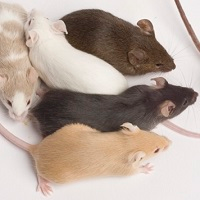JAX® Mice are named according to the guidelines set by the International Committee on Standardized Genetic Nomenclature for Mice, and strain names are revised as necessary to conform to these guidelines.
Learn the highlights of mouse strain nomenclature with our short, interactive tutorial.
Understanding appropriate nomenclature is essential due to the complexity of strain names for substrains, transgenics, knockouts, etc. To enable broader awareness of nomenclature, The Jackson Laboratory has provided the resources below:
Click here to download the Mouse Nomenclature Quick Guide PDF.
The Mouse Genome Informatics (MGI) database is a reliable source of official nomenclature for mouse genes, alleles, and strains; it follows the rules of the International Committee on Standardized Genetic Nomenclature for Mice.

Helpful hints for understanding hybrid strain nomenclature.

Helpful hints for understanding inbred strain and gene nomenclature.
